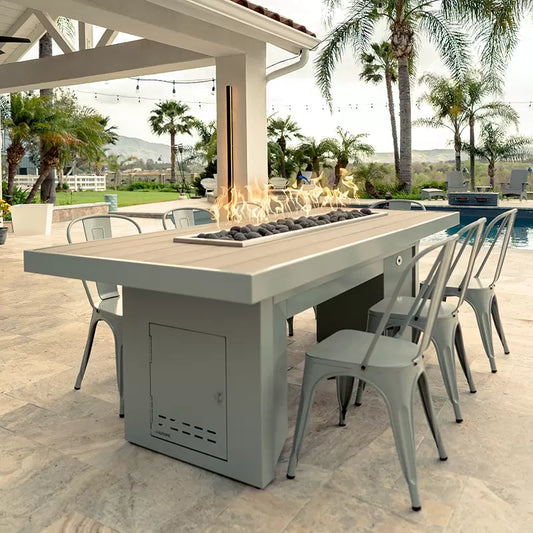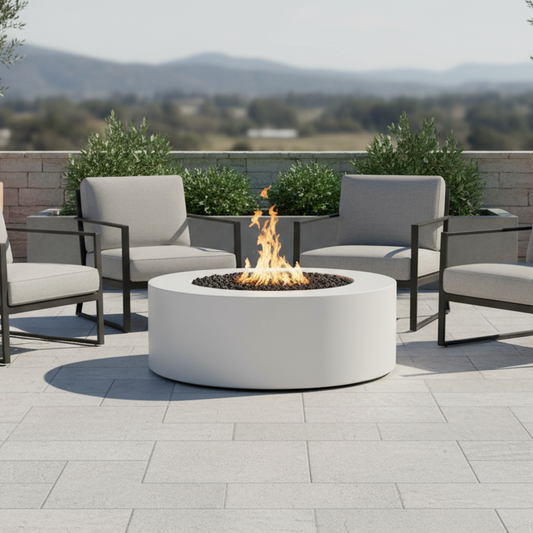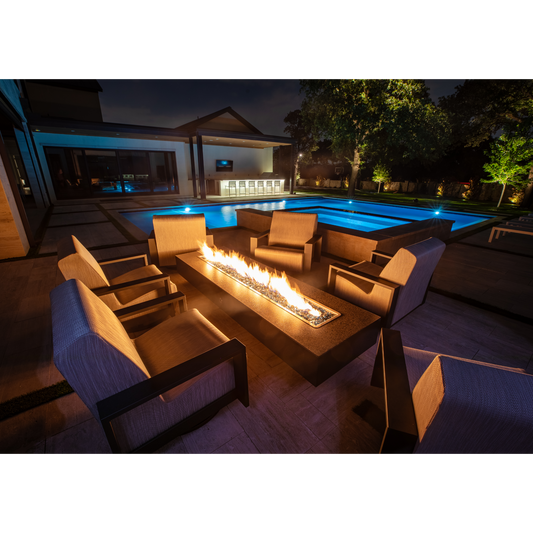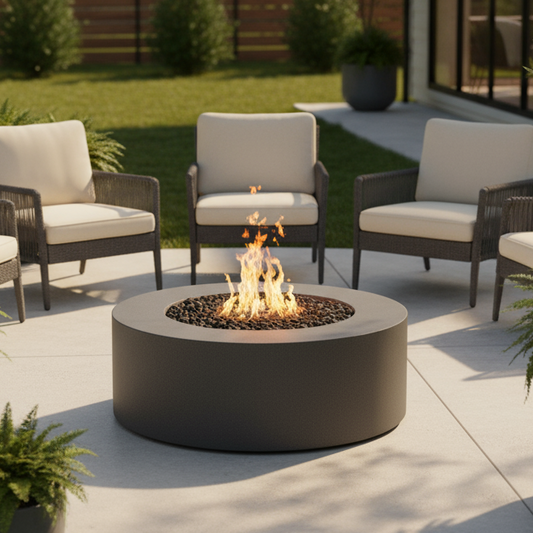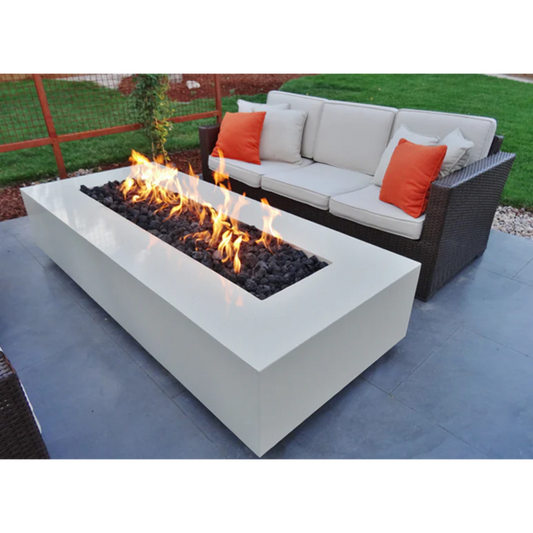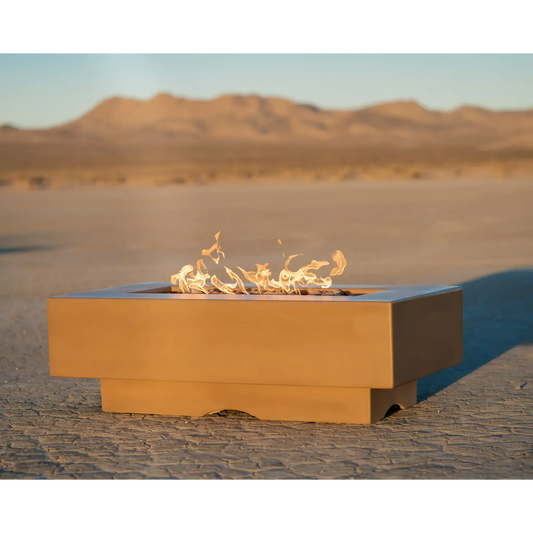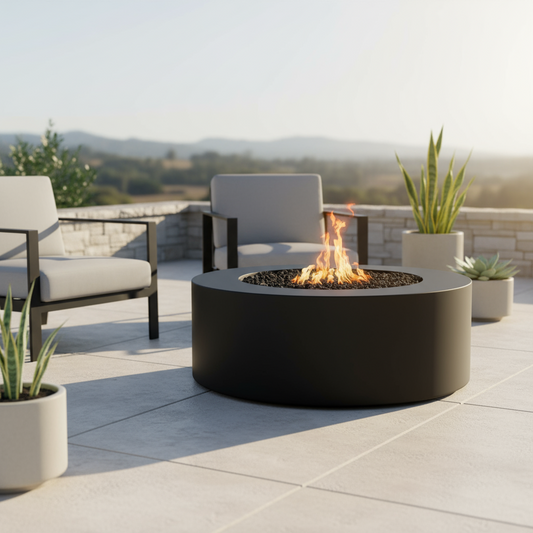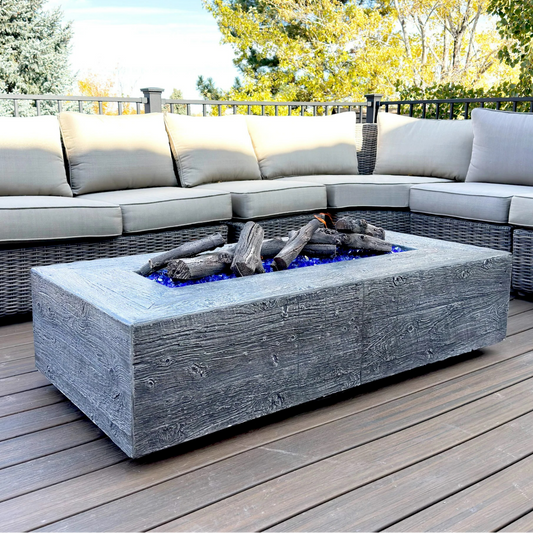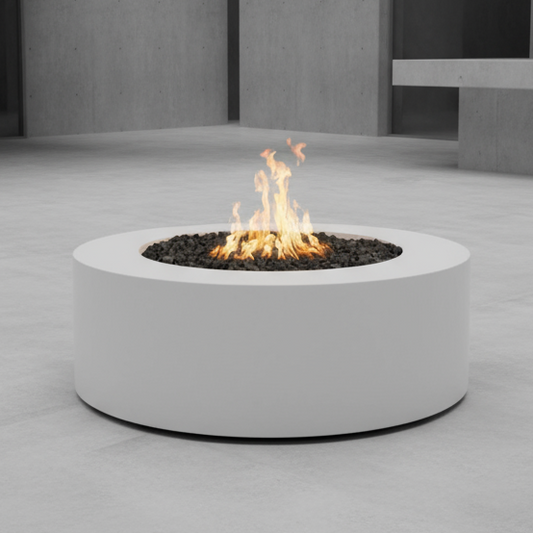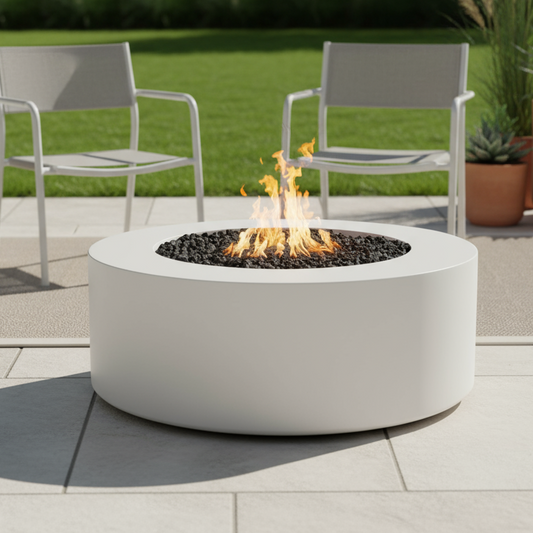Pergolas, Awnings & Covered Structures: Clearance Rules for Fire Pit Tables

Share
The question homeowners ask most is: “Can I use a fire pit table under a pergola or awning?” The short answer: sometimes, but only when height, airflow, and materials work together—and when your model’s manual says it’s allowed. In this spoke you’ll get:
- an at‑a‑glance clearance table for pergolas, awnings, and gazebos,
- a simple measuring method (with dual units),
- the Overhead Safety Triangle framework (Height × Open Airflow × Material Tolerance), and
- optional heat‑management accessories that improve comfort without replacing clearances.
If you landed here while browsing pergola fire pit ideas or gazebo with fire pit inspiration, use this guide to sanity‑check those layouts before you build. For house distances, pergola heights, and landscaping - check out: Fire Pit & Fire Pit Table Safety: Distances, Decks & Trees (U.S. Homeowner Guide)
Table of Content
-
Quick Answer: A Conservative Starting Point
-
The Overhead Safety Triangle (Unique Framework)
-
How to Measure Correctly (Vertical, Lateral & Diagonal)
-
Structure‑by‑Structure Guidance
-
Heat‑Management Accessories (What They Do / Don’t Do)
-
Problem/Solution Mini‑Cases
-
Covered‑Structure Safety Checklist (Printable)
- FAQs
- Conclusion & Next Steps
Key Takeways
-
Conservative baseline (gas units): Keep ≥7–8 ft (2.1–2.4 m) vertical space to the lowest combustible point (beam, rafter, fabric). When you can, aim for 10–12 ft (3.0–3.7 m).
-
Structure matters: Open‑slat pergolas are most compatible; louvered (closed), solid‑roof gazebos, and fabric awnings require more height and stronger airflow (many homeowners retract or avoid fabric during use).
-
No shortcuts: Heat deflectors and wind guards improve comfort but do not reduce manufacturer clearances unless your manual explicitly allows it.
-
Wood-burning (including “smokeless fire pit”): treat as higher risk under any roof—use open sky or much larger setbacks.
-
Always follow the owner’s manual and local code/HOA. This page gives homeowner‑friendly starting points; the most restrictive rule wins.
- For house wall distances, decks, trees, CO/airflow, and shutdown: Fire Pit & Fire Pit Table Safety: Distances, Decks & Trees (U.S. Homeowner Guide)
1. Quick Answer: A Conservative Starting Point
Before you light any gas fire pit under (or near) a roof, confirm the manual and local rules. Then apply these homeowner‑friendly ranges as a baseline.
TABLE: Quick reference – pergola/awning/gazebo types vs min + recommended vertical clearances (ft + m).
|
Structure type |
Minimum vertical (to lowest combustible) |
Recommended vertical |
Notes (lateral/diagonal) |
|
Open‑slat wood/aluminum pergola |
7–8 ft (2.1–2.4 m) |
10–12 ft (3.0–3.7 m) |
Keep 3–5 ft (0.9–1.5 m) to posts/curtains; open sides preferred |
|
Louvered pergola (open) |
8–9 ft (2.4–2.7 m) |
11–12 ft (3.4–3.7 m) |
Treat like open‑slat only when louvers are fully open |
|
Louvered pergola (closed) / solid‑roof pavilion or gazebo |
10 ft (3.0 m) |
12–14 ft (3.7–4.3 m) |
Requires strong cross‑ventilation; avoid partial enclosures |
|
Retractable awning (fabric) |
Retract fully before use |
N/A |
Do not operate directly beneath deployed fabric |
|
Shade sail / canopy / curtains |
Often not suitable |
— |
Keep fabrics far outside the heat plume; prefer open sky |
|
Screened gazebos / partial walls |
10–12 ft (3.0–3.7 m) |
12–14 ft (3.7–4.3 m) |
Open multiple sides; watch CO buildup (link below) |
Important: These are conservative homeowner ranges for gas units. Wood‑burning (including “wood fire pit under pergola” searches) is generally not recommended under any roof due to sparks/embers. When in doubt, choose open sky.
Mini‑wrap: If your current layout can’t hit the recommended height or keep three sides open, consider relocating the appliance or redesigning the pergola. See also: Ventilation & Carbon Monoxide: Outdoor vs Covered Spaces
2. The Overhead Safety Triangle (Unique Framework)
Every covered‑structure setup must balance three variables:
- Height
More height = more dissipation. Measure to the lowest combustible point—beam, rafter, shade cloth, or a hanging décor item. If a fan or heater is present, treat its lowest edge as the limit. - Open Airflow
Open on three or four sides? Great. Add cross‑breeze pathways to whisk away heat and exhaust. Partial enclosures, privacy walls, or glass panels can trap hot gases and stain overhead surfaces. - Material Tolerance
Wood and vinyl warm faster than aluminum or steel. Fabric is the most vulnerable; many awnings require full retraction before use. Watch drip edges for soot streaking.
How to use it: If any corner of the triangle is weak (low height, poor airflow, sensitive materials), compensate by increasing the other two—or by moving the fire pit table to open sky. Accessories can help (next section) but don’t change clearances.
3. How to Measure Correctly (Vertical, Lateral & Diagonal)
- Vertical: From the highest flame tip to the lowest overhead element (beam, louver, fabric edge, light fixture, fan). If flame height varies, use the tallest normal setting.
- Horizontal (lateral): From burner edge (rectangular tables) or burner centerline (round bowls) to the nearest post, curtain, or sidewall. Maintain ≥3–5 ft (0.9–1.5 m).
- Diagonal: Check the corner‑to‑beam distance; diagonal proximity can be closer than straight‑line measurements in tight pergolas.
- Openings & drafts: Windows/doors at the house side can pull air and tilt the flame—verify distances from the house separately here: [LINK: How Far Should a Fire Pit (or Table) Be From the House?]
- On decks? Confirm surface protection and load: [LINK: Deck Safety – Wood, Composite & Stone Decks].
Mini‑wrap: Use painter’s tape and a folding ruler to mark the height line on pergola posts; it’s the easiest way to visualize whether you’ve hit 8, 10, or 12 ft (2.4, 3.0, or 3.7 m).
4. Structure‑by‑Structure Guidance
Open‑Slat Pergolas
- Often the most compatible structure for gas fire pit tables because heat can vent upward.
- Mind beam height and keep three sides open.
- In small backyard fire pit ideas landscaping layouts, avoid filling all sides with screens or planters that block airflow.
Louvered Pergolas
- Open louvers: treat as open‑slat, but confirm the lowest louver angle isn’t trapping heat.
- Closed louvers: behave like a roof—use the solid‑roof clearances and ensure cross‑ventilation.
Solid‑Roof Gazebos/Pavilions
- Require the highest clearances and excellent ventilation.
- Watch for soot staining and beam discoloration over time; see fixes below.
- If browsing gazebo with fire pit inspiration, validate height and open sides before you build.
Retractable Awnings
- Retract fully before operating the fire. Fabric + heat + gusts is a risky combination.
- If you’re gathering fire pit landscaping ideas pictures for an awning space, plan for open sky while the fire is on.
Shade Sails, Canopies & Curtains
- Most fabric canopies are not rated for proximity to open flame. Keep far outside the heat plume or remove while in use.
- Curtains should be tied back beyond your lateral clearance.
Mini‑wrap: Wood‑burning (even “smokeless fire pit” models) under roofs is rarely a good idea. If your design intent is wood fire pit under pergola, re‑site the fire to open air and keep the pergola for seating only.
5. Heat‑Management Accessories (What They Do / Don’t Do)
- Heat deflectors (over-burner plates)
Redirect heat upward and outward, improving comfort for nearby beams. They may reduce staining but do not replace the manufacturer’s required clearances. - Wind guards (tempered glass)
Calm cross‑breezes and keep the flame vertical, which reduces lateral heat on posts and curtains. Again: helpful, but not a clearance waiver.
Wind guard / protective cover • Accessories – Heat Deflectors, Wind Guards, Covers - Covers/Lids
For shutdown and debris control only—never as a heat shield during operation.
6. Problem/Solution Mini‑Cases
Case 1 — Beam discoloration or soot marks
- Situation: After several evenings, the pergola’s central beam shows dark streaks.
- Likely causes: Insufficient vertical clearance; stagnant air; flame hitting a cross‑breeze and leaning toward the beam.
-
Fix:
- Increase vertical spacing (raise the roof line if feasible or move the fire pit table outward).
- Add a heat deflector and a wind guard to stabilize the plume.
- Improve cross‑ventilation (open more sides, remove curtains while burning).
- Clean staining per the beam material’s guidance.
- Increase vertical spacing (raise the roof line if feasible or move the fire pit table outward).
Case 2 — Gusts disturb the flame under an awning
- Situation: The flame “skates” sideways on breezy nights; guests feel alternating hot/cold blasts.
-
Fix:
- Retract the awning completely; if shade is needed, use after shutdown.
- Rotate the burner so its long axis faces the wind; add a wind guard.
- Lower flame height during gusts or relocate to open sky when winds are forecast.
- Retract the awning completely; if shade is needed, use after shutdown.
7. Covered‑Structure Safety Checklist (Printable)
- □ Manual reviewed for overhead clearances; installation allowed under your structure type.
- □ Local code/HOA checked for rules on flame under roofs.
- □ Lowest combustible point identified (beam, fabric edge, fan, light) and measured: target ≥7–8 ft (2.1–2.4 m) minimum; 10–12 ft (3.0–3.7 m) preferred.
- □ Open airflow on ≥3 sides; cross‑ventilation confirmed.
- □ Lateral/diagonal distances to posts/curtains ≥3–5 ft (0.9–1.5 m).
- □ Heat‑management plan: deflector and/or wind guard installed (optional).
- □ Egress paths clear; extinguisher and lid accessible.
- □ Shutdown steps known: off → supply off → cool → cover.
Questions? - Contact a Specialist
8. FAQs
How high should a pergola be above a gas fire pit table?
A cautious starting point is 7–8 ft (2.1–2.4 m) to the lowest combustible, with 10–12 ft (3.0–3.7 m) preferred when space allows. Always follow your manual and local rules.
Can a fire pit go under an awning?
Use open sky—retract fabric completely during operation. Fabric and heat don’t mix, especially in gusts.
Are pergola fire pit ideas safe to build?
They can be—when the design respects height, airflow, and materials (the Overhead Safety Triangle) and when your model is rated for covered use.
Is a wood fire pit under pergola acceptable?
Generally no. Wood (including many “smokeless fire pit” designs) throws embers and runs hotter; move to open air and keep the pergola for seating.
Do heat deflectors reduce required clearances?
No. They can improve comfort and reduce staining but don’t change the clearances in your manual.
Distance to pergola posts or curtains?
Keep ≥3–5 ft (0.9–1.5 m) and tie back fabrics beyond the heat plume.
What about small backyard fire pit ideas landscaping on a budget?
Prioritize open sky installations—create a modest paver pad near your pergola so height and airflow are non‑issues.
9. Conclusion & Next Steps
Covered structures and flames can coexist only when height, open airflow, and material tolerance line up—and when your model and code say it’s okay. Treat 10–12 ft (3.0–3.7 m) overhead as the comfort target, keep three sides open, retract fabric during use, and use deflectors/wind guards as extras, not substitutes for clearance.
-
Compare certified models: Fire Pit Table Collection
-
Add safety gear: Accessories – Heat Deflectors, Wind Guards, Covers
-
Need help validating your pergola/gazebo layout? Contact a Specialist

